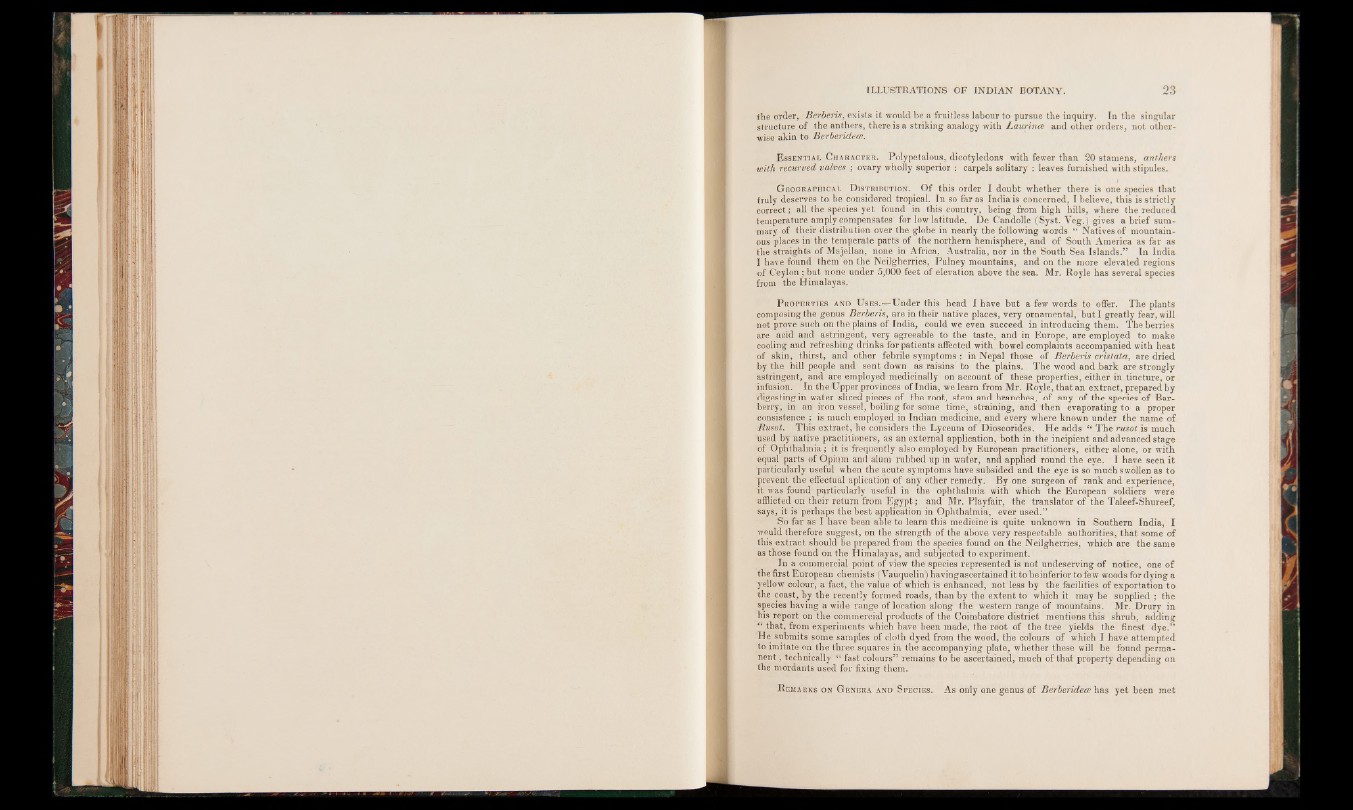
the order, Berberis, exists it would-be a fruitless labour to pursue the inquiry. In the singular
structure of the anthers, there is a striking analogy with Laurince and other orders, not otherwise
akin to Berberidece.
E ssential C haracter. Polypetalous, dicotyledons with fewer than 20 stamens, anthers
with recurved valves ; ovary wholly superior : carpels solitary : leaves furnished with stipules.
G eographical D istribution. Of this order I doubt whether there is one species that
truly deserves to be considered tropical. In so far as India is concerned, I believe, this is strictly
correct; all the species yet found in this country, being from high hills, where the reduced
temperature amply compensates' for low latitude. De Candolle (Syst. Veg.) gives a brief summary
of their distribution over the globe in nearly the following words “ Natives of mountainous
places in the temperate parts of the northern hemisphere, and of South America as far as
the straights of Majellan, none in Africa, Australia, nor in the South Sea Islands.” In India
I have found them on the Neilgherries, Pulney mountains, and on the more elevated regions
of Ceylon; but none under 5,000 feet of elevation above the sea. Mr. Royle has several species
from the Himalayas.
P roperties and U ses.—Under this head I have but a few words to offer. The plants
composing the genus Berberis, are in their native places, very ornamental, but I greatly fear, will
not prove such on the plains of India, / could wp even succeed in introducing them. The berries
are acid and astringent, very agreeable to the taste, and in Europe, are employed to make
cooling and refreshing drinks for patients affected with bowel complaints accompanied with heat
of skin, thirst, and other febrile symptoms : in Nepal those of Berberis cristata, are dried
by the hill people and sent down as raisins to the plains. The wood and bark are strongly
astringent, and are employed medicinally on account of these properties, either in tincture, or
infusion. In the Upper provinces of India, we learn from Mr. Royle, that an extract, prepared by
digesting in water sliced pieces of the root, stem and branches, of any of the species of Barberry,
in an iron vessel, boiling for some' time, straining, and then evaporating to a proper
consistence ; is much employed in Indian medicine, and every where known under the name of
Rusot. This extract, he considers the Lyceum of Dioscorides. He adds “ The rusot is much
used by native practitioners, as an external application, both in the incipient and advanced stage
of Ophthalmia; it is frequently also employed by European practitioners, either alone, or with
equal parts of Opium and alum rubbed up in water, and applied round the eye. I have seen it
particularly useful when the acute symptoms have subsided and the eye is so much swollen as to
prevent the effectual aplication of any other remedy. By one surgeon of rank and experience,
it was found particularly useful in the ophthalmia with which the European soldiers were
afflicted on their return from Egypt; and Mr. Playfair, the translator of the Taleef-Shureef,
says, it is perhaps the best application in Ophthalmia, ever used.”
So far as I have been able to learn this medicine is quite unknown in Southern India, I
would therefore suggest, on the strength of the above very respectable authorities, that some of
this extract should be prepared from the species found on the Neilgherries, which are the same
as those found on the Himalayas, and subjected to experiment.
In a commercial point of view the species represented is not undeserving of notice, one of
the first European chemists (Vauquelin) havingascertained it to beinferior to few woods for dying a
yellow colour, a fact, the value of which is enhanced, not less by the facilities of exportation to
the coast, by the recently formed roads, than by the extent to which it may be supplied ; the
species having a wide range of location along the western range of mountains. Mr. Drury in
his report on the commercial products of the Coimbatore district mentions this shrub, adding
“ that, from experiments which have been made, the root of the tree yields the finest dye.”
He submits some samples of cloth dyed from the wood, the colours of which I have attempted
to imitate on the three squares in the accompanying plate, whether these will be found permanent,
technically “ fast colours” remains to be ascertained, much of that property depending on
the mordants used for fixing them.
R emarks on G enera and Species. As only one genus of Berberidece has y e t been m et